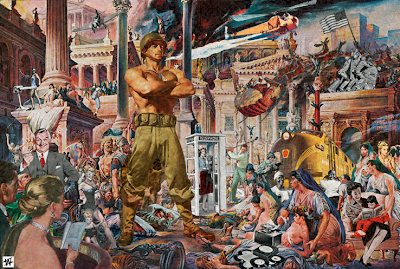
Winston Smith, hand made montage
Project #1: Collaborative Digital Diptych Montage
Objective:
After being paired up, you and your partner will create a digital diptych responding to an over-arching theme we will choose on our first day of class. Please start thinking of some ideas. What are interesting topics we can pursue? Should it be social commentary, personally reflective, or maybe a concept based on the idea of pairs, dual, or binary? Every groups piece will start with our chosen theme for their conceptual place of departure.
You will create your digital montage in Adobe Photoshop from specific source material. You and your partner will use the same 25 source materials as your subject matter. The strategy you use to pick your images is up to you. Maybe you can each select 12 apart from one another and swap or you can meet together and search for your chosen images. These 25 source images are to be comprised from some combination of the following: scanned objects (flatbed scanned), images appropriated from books and magazines (flatbed scanned), and images downloaded from the Internet. At least one of the images you use must be of a word that is visible to the viewer.
All images are to be found or otherwise appropriated (including the word – scan text from an original print source). Use Adobe Photoshop to creatively combine your image elements into cohesive image compositions that will exist as a diptych. Remember, each of your images MUST include all 25 of your source images in each composition! Consider the conceptual link between image, object and word that will be created by their combination.
Very important! Save your images with layers intact as we will be further using your image for the next project (animation). I will show you the specifics in class.
Examples:
Consider the possibilities of Adobe Photoshop to cut, paste, resize, etc.. Scan photographs from family albums, magazines, etc.. Bring in various found objects to scan - junk, a meaningful keepsake, etc.. Pick a word or words, either scanned from text, handwritten or otherwise created outside of the computer, scan it and include the work in the image. Think about how the creative unexpected associations of disparate images and texts functions to establish new and multiple readings of the works.
Techniques:
Much of this you will learn by doing – basics will be demoed in class - Adobe Photoshop, image scanning, image sizes, resolution, etc.
Image Size for each of the two images:

Due Dates: Monday February 4th
Part 1 - Completed Diptych (Both yours and your partner's) posted to your blog! Save your files in the above noted size and resolution. Save a second set of each image, first flatten each image in the layers palette, then save at 50% at 72ppi for web resolution - then and only then upload the images to your blog. Be sure not to overwrite your originals!
You must also include a brief artist statement about your work. This may be composed by your group or as individuals.
Part 2 - Reading - The Work of Art in the Age of Mechanical Reproduction - Walter Benjamin - Write two critical questions for discussion! Post these to your blog! Please write intelligent, probing questions that allow for deep discussion...see this link for some helpful advice for creating good discussion questions: http://homepages.wmich.edu/~acareywe/discussion.html
Some useful Photoshop Tutorials:
http://www.adobe.com/designcenter/video_workshop/
http://www.adobe.com/support/photoshop/gettingstarted/index.html
http://www.youtube.com/watch?v=PVnza1_BlPo
http://vimeo.com/14437441
http://vimeo.com/15139239
http://vimeo.com/14551877
These are just a few of the many thousands of tutorials available free, online, take a look try some of these techniques! If you are curious about specific functions of any program, type in the name of the function in Google with "_________ tutorial" and you will find the information you need!
Please take the time and look through the powerpoint slides embedded above and the links below. You might notice that I did not show you ANY works by artists working with computers to create their work. Physical montage seems to have a gravitas, a weight of form and content that has never quite been matched by the possibilities of digital photo processing. You might think about this as you create your compositions.
http://winstonsmith.com/
http://www.jonathanallen.org/collage.html
http://matthewrosestudio.net/Matthew_Rose_COLLAGES_A_KICK.html
http://hollischorno.com/index.html
http://www.fredtorres.com/artists/george-rahme/
http://www.chamblissgiobbi.com/index.html
http://mattcusick.com/paintings-collage/map-works/view/197
http://www.chamuconegro.com/
No comments:
Post a Comment